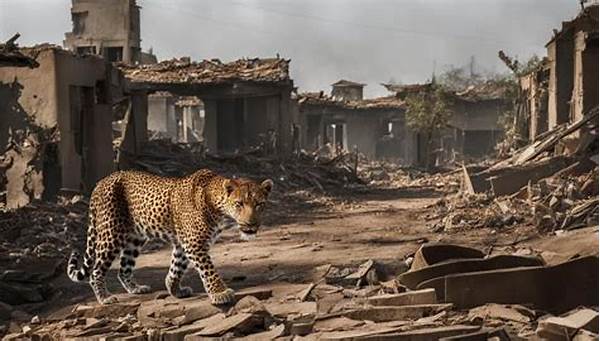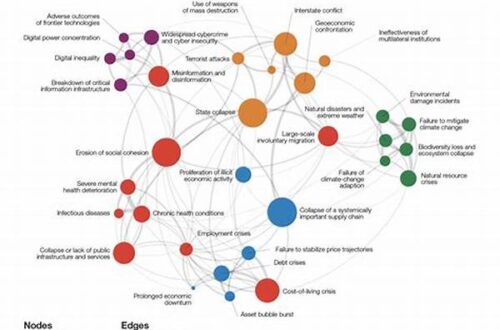In recent decades, the environmental impact of human activities has become a critical point of concern for global communities. Among these impacts, habitat destruction in conflict areas has emerged as a particularly troubling issue. Conflicts often arise in regions rich in biodiversity, where both fauna and flora are deeply affected by military activities, resource exploitation, and population displacement. This article delves into the causes and consequences of habitat destruction in conflict areas, highlighting the urgent need for sustainable solutions to preserve these vital ecosystems.
The Causes of Habitat Destruction in Conflict Areas
The primary drivers of habitat destruction in conflict areas include deforestation, mining, and uncontrolled urban expansion. Warfare scenarios can lead to significant environmental degradation, characterized by the clearing of land for military bases and unauthorized logging operations. Moreover, the extraction of resources, such as oil and minerals, which often finance armed conflicts, leads to extensive landscape alterations and pollution. Population displacement induced by conflict further exacerbates deforestation as displaced populations clear forests for temporary shelters and farming. The cumulative impact of these activities accelerates habitat degradation, posing severe threats to the biodiversity that thrives in these areas.
Conflict-induced habitat destruction poses dire consequences for wildlife and ecosystems. The disruption of natural habitats affects animal migration patterns and reduces species survival rates. Indigenous plants and animals face the risk of extinction as their habitats are fragmented or eradicated. Additionally, these changes can cause imbalances in local ecosystems, leading to the proliferation of invasive species. Therefore, addressing habitat destruction in conflict areas is essential to maintaining ecological balance and conserving biodiversity.
The Impact on Biodiversity Due to Habitat Destruction in Conflict Areas
1. Habitat destruction in conflict areas results in the loss of biodiversity, as flora and fauna are forced out of their natural environments.
2. Endangered species are at greater risk of extinction as their habitats are destroyed or fragmented due to combat activities.
3. Displaced populations often resort to exploiting natural resources, leading to further habitat degradation.
4. The introduction of military machinery produces soil compaction and erosion, which worsens habitat destruction in conflict areas.
5. Wildlife displacement due to habitat destruction disrupts ecological networks, impacting both local livelihoods and global biodiversity.
Economic Implications of Habitat Destruction in Conflict Areas
The economic ramifications of habitat destruction in conflict areas are multifaceted. The loss of biodiversity leads to a decline in ecosystem services, which directly impacts agriculture, fisheries, and forestry. These sectors are crucial for the livelihoods of many communities, particularly in developing regions. The reduction of these resources can lead to increased poverty and food insecurity, further destabilizing vulnerable populations. Restoration efforts are often required, demanding substantial financial resources that could otherwise support sustainable development initiatives.
Investing in conservation and restoration programs in conflict areas can yield economic benefits in the long term. By halting habitat destruction and promoting sustainable practices, countries can preserve their natural resources, support tourism, and create job opportunities. International collaborations and financial aid from global institutions can play a significant role in addressing habitat destruction in conflict zones, providing both immediate relief and long-term solutions. Through strategic planning and sustainable management, it is possible to mitigate the adverse economic impacts and foster resilience in these regions.
The Role of International Organizations in Mitigating Habitat Destruction in Conflict Areas
International organizations have a critical role in addressing habitat destruction in conflict areas. By providing both technical and financial support, these entities can help implement robust conservation strategies. Collaborative efforts with governments and local communities are vital in crafting policies aimed at reducing environmental damage and promoting sustainable resource management.
1. Habitat destruction in conflict areas can be mitigated through global partnerships focused on rehabilitation and conservation.
2. International relief agencies can offer resources for immediate restoration efforts to counteract environmental damage.
3. Raising global awareness about the impact of habitat destruction in conflict areas encourages collective action and investment.
4. Policy advocacy by international organizations can influence government decisions to prioritize environmental conservation during peacetime.
5. Cross-border collaborations facilitate knowledge exchange, which helps implement effective ecosystem management practices in conflict areas.
Sustainable Solutions to Combat Habitat Destruction in Conflict Areas
Addressing habitat destruction in conflict areas requires a holistic approach that involves multiple stakeholders, including governments, NGOs, and the private sector. Initiatives such as peacebuilding and environmental education can raise awareness about the importance of preserving natural habitats. Incorporating traditional knowledge can enhance the effectiveness of conservation strategies and ensure community buy-in.
Conservation technologies, such as satellite monitoring and GIS mapping, can track and manage environmental damage in conflict zones in real time. These tools help assess the extent of habitat loss and guide targeted restoration efforts. Integrating environmental considerations into peace agreements and reconstruction plans can aid in establishing lasting solutions to habitat destruction in conflict areas. Furthermore, promoting sustainable resource use and livelihoods for conflict-affected populations can alleviate pressure on ecosystems and contribute to long-term ecological preservation.
The Legal Framework Addressing Habitat Destruction in Conflict Areas
Legal frameworks play a crucial role in mitigating habitat destruction in conflict areas. International treaties, such as the Convention on Biological Diversity, provide guidelines for protecting natural habitats and promoting sustainable resource use. National legislations must align with these frameworks to effectively address environmental issues in regions experiencing conflict.
Enforcement of environmental laws in conflict areas is often challenging due to limited governance and instability. Therefore, strengthening legal institutions is essential to ensuring accountability and compliance. Encouraging international cooperation and capacity building in environmental law enforcement can fortify efforts against habitat destruction. Additionally, integrating environmental protection clauses in peace agreements can facilitate sustainable development in post-conflict reconstruction.
Conclusion: The Future of Habitat Conservation in Conflict Areas
The issue of habitat destruction in conflict areas calls for immediate and concerted action from the global community. Conservation efforts must be prioritized alongside peacebuilding initiatives to preserve the environment and promote sustainable development. Both short-term interventions and long-term strategies are needed to effectively address the challenges posed by conflict-induced habitat loss.
The future of habitat conservation in conflict areas hinges on international collaboration, innovative technologies, and comprehensive policy frameworks. Emphasizing environmental considerations in conflict resolution and reconstruction processes can ensure that natural habitats are protected and restored for future generations. By recognizing the intrinsic value of these ecosystems, stakeholders can work together to prevent further destruction and maintain the delicate balance between human needs and environmental sustainability.





